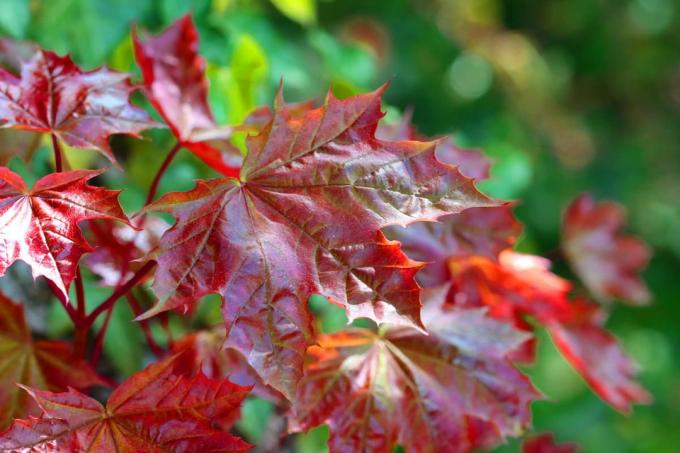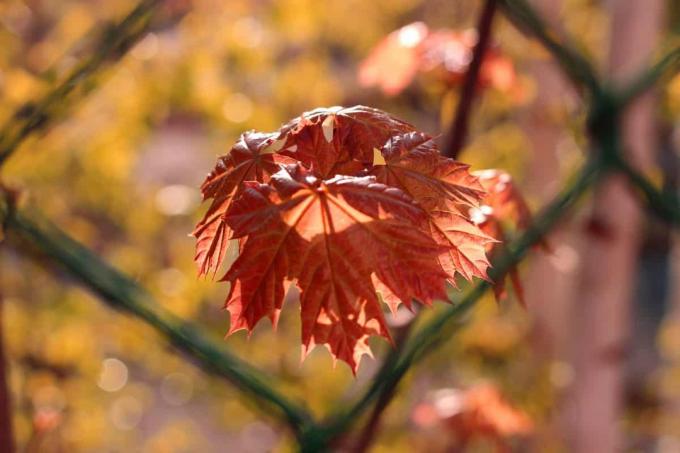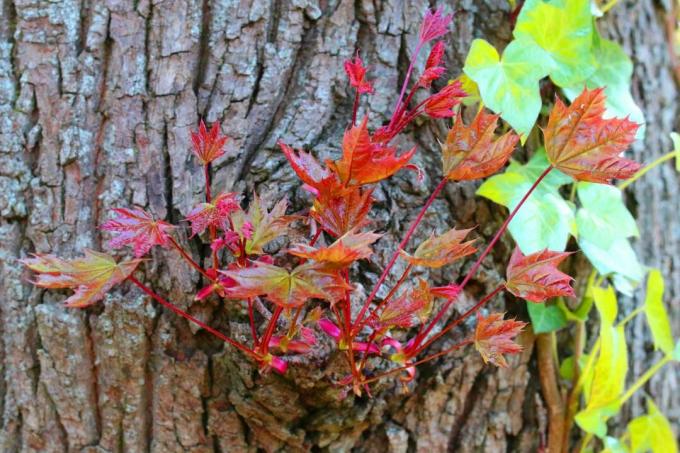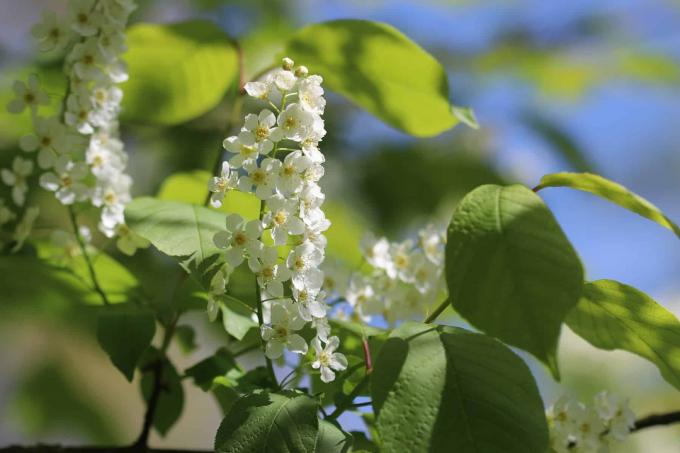

Table of contents
- Description of the blood maple
- location requirements
- Use and plant partner
- planting
- propagation
- watering routine
- Fertilize
- cut
- wintering
- care mistakes
- diseases and pests
The blood maple (Acer platanoides) is originally native to the forests of East Asia. The intense reddish coloring of the leaves, which adorn the tree throughout the year, has contributed to its great popularity.
Description of the blood maple
- Height of growth: ten to fifteen meters
- Gender: unisex
- Type of pollination: cross-pollination
- Leaves: deciduous
- Leaf shape: five to seven lobed
- Leaf color: red
- Flowering time: April to May
- Flower shape: umbels
- Fruit ripening: October
- Fruit shape: split fruit
location requirements
Acer platanoides has very low demands on its location, so it can be planted in almost any habitat. It prefers a sunny to partially shaded position in a wind-protected position. With regard to the selection of the right soil substrate, there are also only a few special features to consider. It also impresses with its high lime tolerance and low nutrient requirements. The density of the soil should not be too high, but rather have a loamy to sandy and permeable consistency.
A notice:
Did you know that the red maple is one of the most popular solitary trees in this country?
Use and plant partner
The red maple is characterized by its striking red leaf color for a prominent individual position in the garden. Furthermore, the cultivation of plant partners in the immediate vicinity is not recommended in view of the growth height and width as well as the spreading root system.
A notice:
If you don't have the space in your garden to plant a red maple outdoors have, also offers a cultivation in a bucket or the use of a root barrier in the ground on.
planting
The red maple can be planted continuously in the frost-free period. However, the best time to plant is spring, as this gives the tree sufficient time to grow and thus become more resistant to frost. Seedlings planted later in the year need separate frost protection for the winter.

The pot ball should be placed in a hole that is not too large, so that about one to two centimeters protrude. Sufficient watering of the plant is then necessary to support root growth. Furthermore, the integration of a support post is recommended to stabilize the young plant.
Tip:
If you want to accelerate the growth of your seedling, it is advisable to start it together with horn shavings.
propagation
There are two ways to propagate the red maple: propagation by cuttings or by sowing. When propagating via cuttings, a young shoot is removed from the tree that is not yet excessively woody and is a maximum of 20 centimeters long. This is planted in a substrate mixture mixed with root powder to stimulate root formation. After the expulsion has taken place, the young plant can then be cultivated in another bucket or outdoors.
When reproducing by sowing, the following steps must be observed:
- Collect fruits when they ripen in autumn
- Drying of the fruits and the seeds they contain over the winter
- Stratify seeds in spring through moisture and cold
- Sow in tubs or outdoors after the frost period
Tip:
The blood maple often multiplies itself by sowing in the home garden. So keep an eye out for young plants around your tree.
watering routine
Acer platanoides is one of the shallow roots, so the root area dries out quickly, especially in the warm summer months. Accordingly, it is necessary to ensure adequate watering, which can be supplemented by additional measures such as covering the roots with mulch. The mulch fulfills two protective mechanisms in particular: On the one hand, it prevents excessive Evaporation of moisture from the layers of earth and on the other hand the burning of the sensitive ones root shoots. However, care should be taken in the event of waterlogging, as this can lead to rotting processes. This often occurs in the rainy months or when cultivating in pots. Therefore, when cultivating in tubs, the following instructions should be observed in particular:
- Equip pots with drainage holes
- Avoid coasters if possible or empty regularly
- Use your finger to feel the soil to a depth of three centimeters
Fertilize
Since the tree prefers nutrient-poor soils, continuous fertilization is not necessary. For young plants, however, it is advisable to add horn shavings, compost or other organic fertilizer in the spring. In addition, fertilization may prove necessary if growth slows down or if the leaf crown develops irregularly.
Tip:
Take extra care to prevent over-fertilizing the tree. With regard to fertilization, the red maple should be used sparingly in order to rule out increased susceptibility to disease or pest infestation.
cut
Like its related maple genera, the red maple tolerates pruning very poorly. Essentially, this is due to the high sap flow, which can cause the tree to bleed out if pruned excessively. However, with the right termination, this risk factor can be significantly reduced, since in the course of the regular Growth cycle the sap pressure decreases continuously in the autumn of each year until it is completely during the frost period dried up. Basically, the pruning serves to thin out the crown of the tree, as this would otherwise wither excessively in the inner area.
- Only use clean, preferably sterile, tools for the cut
- Preferably remove dry branches
- Shortening branches that are too long by a maximum of 50 centimeters
- Carry out maintenance cuts every two years at the latest
wintering
Acer platanoides is generally very hardy, but young plants and specimens grown in pots still need additional frost protection. The sensitive root area should be protected by breathable materials such as leaves, brushwood, jute or bast. In the case of potted plants, the pot itself should also be protected with polystyrene to protect the substrate from frost damage.
care mistakes
Too much water
If your red maple has dried leaves and shoots, this is mainly due to mistakes in care due to excessive or too sparing watering or too much fertilizer. By examining the surrounding soil surface and strata, any moisture problems can be quickly identified. Therefore, provide additional watering if the soil is too dry and vice versa if the soil is moist, do not add more liquid.
over-fertilization
Despite the low nutrient requirements of the red maple, over-fertilization can occur Malformations in the branches and leaves result, since the enormous amount of substances contained inhibits growth. It is therefore advisable to use the nutrient supply only rarely and especially in spring and to avoid it over the rest of the year if possible.
site selection
Another reason for an unsightly appearance could also be the choice of location of the tree. If you choose a location that is too shady, it is not possible for the plant to develop strong and strong shoots and leaves. In this case, only a new location change to a sunnier spot can help.
Tip:
A change of location should always be the last measure to be taken with a sick tree, as this represents an additional burden for the plant.

diseases and pests
wilt fungus
The red maple is particularly susceptible to fungal diseases, which penetrate the tree through injuries in the bark. A widespread species is the wilt fungus, also known as Verticillium wilt, which is an incurable disease to date. The main feature is the drying up of leaves and twigs. Since there is currently no effective fungicide, the options for treating the wilt fungus are very limited. If the symptoms are recognized in good time, the affected regions can be removed using a large section. If the concentration of fungi in the other tree regions is not too high, there is a chance that these areas will survive. In addition, you should make sure that the soil around the tree is not too moist and that it is well drained with sand or compost.
mildew
Powdery mildew is also a fungal disease, but is much less dangerous than the aforementioned wilt fungus. Externally, powdery mildew appears as a whitish coating that settles on the leaves. In addition to the use of an appropriate fungicide, a self-made one has proven itself in practice Mixture of milk and baking powder in a ratio of 1: 8 established on the affected areas is sprayed on.
aphid infestation
Aphid infestation, like powdery mildew, is one of the most common diseases affecting our native plants. Even if the small animals can hardly be seen by the human eye, the effects of an infestation are all the more obvious. As their name suggests, the aphids infest the leaves and extract the vital plant sap from them. This causes the individual leaves to gradually shrivell and curl up. If the infestation has not progressed too far, it is often sufficient to clean the plant of the lice with a powerful jet of water. In addition, however, the administration of a special insecticide is recommended.
 garden editorial
garden editorial I write about everything that interests me in my garden.
Learn more about Baumlexikon

Bird cherry, Prunus padus: caring for, pruning & propagating
The bird cherry is a shrub or tree that is the ideal bee pasture in a natural garden. However, the plant should also be viewed with caution, as it is a poisonous plant for horses. Nevertheless, it is popular in the local colorful hedges.

Sycamore tree: Properly care for and cut sycamore trees
The plane tree (Platanus) has a high decorative value. In terms of care, it is mostly undemanding, which is why it is often chosen as a street tree. Nevertheless, there are a few details to be observed when it comes to care, as described in the home garden guide.

Birch locations: 5 important criteria
Birch trees are extremely frugal trees and are particularly eye-catching and decorative thanks to their light-colored bark. When choosing a location, however, a few factors should be considered in order to create optimal conditions for their growth and to protect the environment.

Cutting dwarf pine - instructions for the perfect cut
Dwarf pines can be pruned by thinning out, topiary or limbing. A bonsai design with needle and root pruning is also possible. So that the wood does not look unattractive after the pruning measure, a few rules of technology should be observed.

Is the vinegar tree poisonous? | Who is it dangerous for?
In ornamental gardens, the vinegar tree is an attractive eye-catcher due to its unusual flowers and the appealing autumn color of its feathered leaves. The red, upright fruit cobs (flowers) are responsible for the striking appearance. Despite everything, the vinegar tree is not an unproblematic tree.

Vinegar, Rhus typhina | Care from A – Z
The vinegar tree is an easy-care plant for the garden and tub with a special autumn color. Only its uncontrolled spread can lead to problems in the garden. However, this can be curbed with a root barrier.



